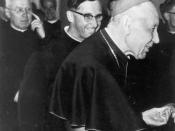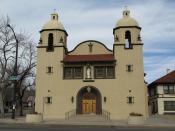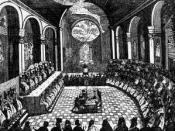Origins of the Catholic Church in Australia
The First Catholics to come to Australia were the Catholics on the first fleet. These people were mostly Irish convicts who were sent out for committing a crime. They were sent here because the jails in England were getting over crowded and they need to find a place for them. Most Catholics that came to Australia spoke Gaelic.
In the late 1940's, people started coming from Eastern Europe and later one more refugee's came from southern Europe, northern Europe and Netherlands. This was because of the war that was happening at the time. When the Europeans came, they had different practices, they weren't strict when it came to going to mass on Sundays, and they worshiped different saints and celebrated religious events differently.
Catholic practices prior to 1962
Prior to 1962, the priest was saying the homily from "pulpit" which is a really high stand at the front, it had a gothic look to it, it was set out in the shape of a cross and had lost of candles, flowers and pictures of Jesus.
Prior to 1962, the mass was in Latin. The homily was said on the pulpit, it was more formal such as clothing. Most of the time, the priest would have his back facing towards you, people who were getting married had it done on the lower alter and before communion, they had confession.
Benediction was a prayer that was done over a day, this was dedication to the sacred host; Novenas were a number of prayers said over nine days, this was a dedication to Virgin Mary. These could be done publicly or privately. The Rosary was a prayer that was done in one day; it consisted of the Our Father, Hail Mary and Glory To Be.
Even fasting was part of the practices before 1962, they weren't aloud to eat meet on Fridays or on Ash Wednesday. It was practiced because people were scared of going against the church.
Catholic organizations
St Vincent De Paul's society was started In France in the 1800's; they helped the poor, provided them with clothing, food advice or cash. It was from Lay men and women.
A layman called Frank Duff founded Legion Of Mary in Ireland 1921. They fostered the spiritual life of members while directing them to an active apostolate, which included visiting parishioners. The grail was formed by the women of Europe and came to Australia in mid-1930. They ran courses so women from all over Australia to attempt to embed Christianity into Australian Culture.
The Role of the religious and laity
The priests would carry out the mass, they would also provide counselling to students who were in need of comforting, while the nuns ran the schools and taught the students.
The laity had the responsibility to the kids how to be a good catholic, bring them up to learn about Jesus' teachings.
Catholic education's in schools
One of the first catholic schools was established by John Therry in Parramatta in 1920, later on in 1966, Mary MacKillop and Father Julian Tennison Woods created the sisters of St Joseph. This was made so the poor children in South Australia could have an education. This was made to teach the children about true faith, they were taught to use their beliefs in everyday life. The fee's were paid by the parents, Nuns and lay teachers taught about the catholic faith at the school, in the government schools, children weren't taught about faith because their were children who didn't believe. The class sizes consisted about 80 kids, the subjects that were offered were literature, some languages, textiles, music, sport and mathematics, this was all good but their was one major problem, Money. This was because more teachers were need so the prices had to keep going up.
Catholics and non-Catholic relationships
Back then, the Catholics were not aloud to associate with the non-Catholics because they were seen as crazy people or protesters because they didn't study the bible and went to church when ever they wanted to, they had different beliefs and celebrated different times.
Church Councils
There have been many official church types of council in the Catholic Church. They mostly discuss the way the church is been run and to question certain aspects of how this is done. There has been 21 Church Councils recorded.
Second Vatican Council
The most recent Ecumenical Council held by the Catholic Church is the Second Vatican Council in 1962 - 65. This council was initiated by Pope John the 23rd and continued in 1963 by Pope Paul 4th. Pope John initiated it because he wanted to bring the Church up to date with the Modern World he also aimed to promote Christian Unity. The areas addressed were dignity of human race, refocusing on God; we have to love thy neighbour, the importance of mass, and sexuality and Christianity survival in the Modern World. At the end of Vatican two the church took on some new directions, these were; Renewed attention to God's word, Religious Freedom, More active role of the laity, Social Justice, Adaptation and Unity among Christian religions.
Evaluation
The many changes of Vatican Two have had a strong impact. Being able to worship freely made the world definitely a better place. I feel that all the changes made by Vatican Two have benefited the church greatly because were more for to have a say in religion and not get chased and killed or become an outcast.


